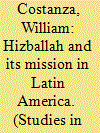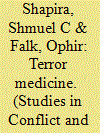| Srl | Item |
| 1 |
ID:
110855


|
|
|
|
|
| Publication |
2012.
|
| Summary/Abstract |
Despite plentiful scholarship relating to the prospect of terrorists utilizing chemical, biological, radiological, or nuclear (CBRN) weapons, little of this work is both quantitative in nature and global in scope. Leveraging open-source data, this study quantitatively explores factors influencing the terrorist organizational decision to pursue CBRN weapons. The findings suggest that organizations embedded in alliance structures and based in authoritarian countries with relatively strong connections to a globalized world are more likely to seek to develop or acquire CBRN weapons. Contrary to previous qualitative studies, the present study failed to find a significant relationship between CBRN pursuit and religious ideology.
|
|
|
|
|
|
|
|
|
|
|
|
|
|
|
|
| 2 |
ID:
110853


|
|
|
|
|
| Publication |
2012.
|
| Summary/Abstract |
The activities of Hizballah in Latin America generally have been viewed by governmental authorities in the region as a security concern primarily because of its importance in bilateral relations with the United States rather than as an internal terrorist threat targeted against their sovereign interests. This article explores Hizballah's network and past activities in South America to assess the nature of Hizballah's strategic aims in the region in support of its global organizational goals. The author argues that the perception of Hizballah as a legitimate political organization by Latin American governments has hampered efforts to effectively apply counterterrorism resources to root out the entrenched Hizballah infrastructure in the region that can potentially carry out directives by the Hizballah leadership or by serving as a proxy of Iran.
|
|
|
|
|
|
|
|
|
|
|
|
|
|
|
|
| 3 |
ID:
110854


|
|
|
|
|
| Publication |
2012.
|
| Summary/Abstract |
Operations to counterterrorism in the southern Philippines have resulted in the arrest and incarceration of a significant number of key militants. As a result, the Philippine government has expressed concern that these inmates may radicalize others and continue to operate while incarcerated. As a preventive measure, the government has considered a number of "soft" counterstrategies, including the development of a de-radicalization program. To study the feasibility of running such a program in the Philippine corrective system, this article examines two interrelated areas of enquiry concerning how terrorist inmates are housed and whether prison gangs foster or discourage radicalization in the Philippine prison system. Initial findings suggest that the integration of terrorist inmates with prison gangs may temporarily encourage disengagement and set the foundations for de-radicalization. However, without a specifically designed intervention strategy, the terrorist inmates may revert to militancy once they have returned to their original social settings.
|
|
|
|
|
|
|
|
|
|
|
|
|
|
|
|
| 4 |
ID:
110856


|
|
|
|
|
| Publication |
2012.
|
| Summary/Abstract |
The surge in mass casualty terror attacks during the first decade of the 21st century presented a special challenge for health organizations. Unique types of injury resulting from these Mass Casualty Events called for special capabilities to restore the balance between immediate demands and scarce resources. Post Traumatic Stress Disorder (PTSD), to both victims and healthcare providers and first responders required extra knowledge and early intervention. All these and the concerns of the possibilities of non-conventional weapons terror attacks, led to the defining of "Terror Medicine", a new medical field. This field evolves the medical macro management of terror attacks, the focused clinical management of the specific injuries and coping with the aftermath consequences. The scope of Terror Medicine is: Prevention, Preparedness, Response and Recovery. The evolution and trends of Terror Medicine is discussed in this article.
|
|
|
|
|
|
|
|
|
|
|
|
|
|
|
|